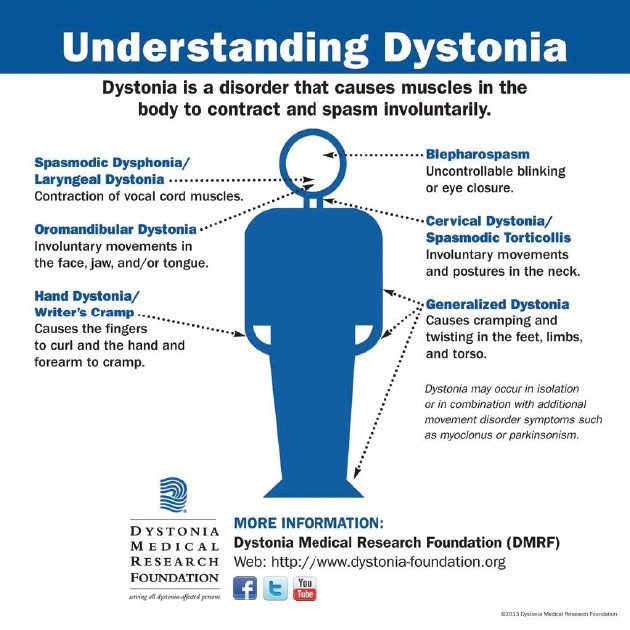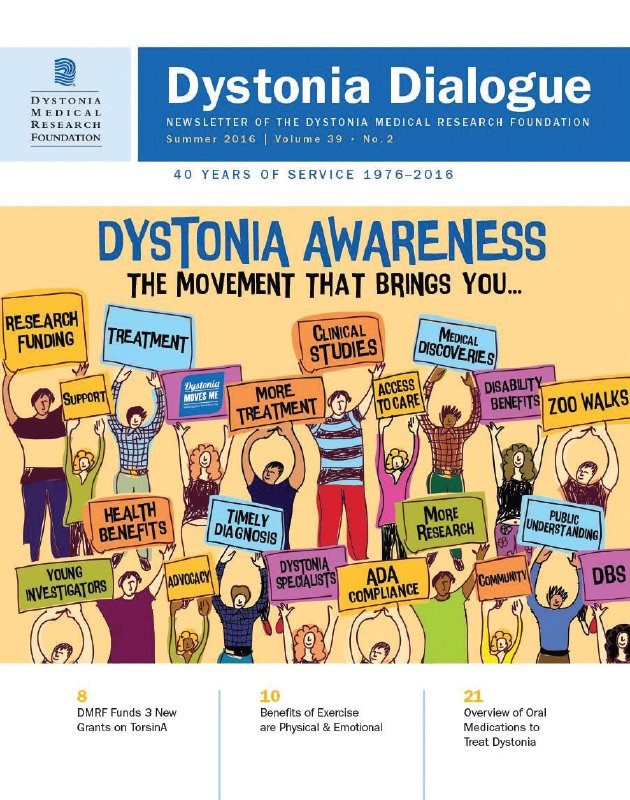×
By Lisa J. Gotto
brFor some people, it manifests itself as an involuntary shaking of the head, writer’s cramp with difficulty writing, or an inability to vocalize, among other symptoms.
brbrDo you or someone you know suffer from chronic ailments like these and are they substantially affecting the quality of their life? You may have even been to your physician, but are still experiencing symptoms despite what the doctor has prescribed for you. If this is the case, you may be suffering from a condition known as Dystonia.
brbrSeptember is Dystonia Awareness Month, a campaign dedicated to increasing visibility for this disorder, which affects men, women, and children of all ages and backgrounds, according to the Dystonia Medical Research Foundation. The DMRF states that more than 300,000 people in the United States and Canada are affected by this disorder, which is sometimes misdiagnosed as stress, a stiff neck, or a psychological disorder.
brbrFor many the journey to a proper diagnosis can be a frustrating one fraught with trial and error, setbacks, medical wait times, and the stress that comes with the unknown.
brbrDebbie Carta of Odenton has lived that journey, but has emerged as an advocate with a clearer picture of what she is dealing with and how best to treat it.
brbr“I have read that it can take seeing 15 doctors and five years to get a diagnosis, if you get one at all,” she says.
brbrCarta’s primary symptoms at onset were head tremor and hoarse throat. “I had head tremor for about eight years that was not too severe, but then it became very severe and worsened over an 18-month period.”
brbrDuring that “not too severe” period Carta consulted with a physician and eventually met with a neurologist during the early stages. The advice was to stop drinking coffee. “I did, but it did not help at all.”
brbrShe had terrible headaches, a stiff neck and shoulders, and her posture became misaligned. She sought the help of a second neurologist, who diagnosed she was suffering from migraines.
brbr“I visited my primary care doctor over and over, two different ENT’s (ear, nose, and throat doctors) a rheumatologist, and an infectious disease doctor. I was sent to physical therapy and to two chiropractors.” She received an inaccurate diagnosis of Lyme disease at one of her visits.
brbrWhat she would learn and what is probably the toughest aspect of getting properly diagnosed is the complexity of Dystonia—which is a rare and chronic brain condition in which the brain sends signals to the nerves thus causing severe muscle contractions. These contractions cause shaking and sometimes violent muscle movements.
brbrIt was Carta’s third attempt, this time with a movement disorder neurologist at Johns Hopkins, that finally yielded some relief and much needed answers. “I had to wait eight months for an appointment and diagnosis, and another three to begin treatment, but it was well worth it.”
brbrCarta is now on that treatment plan to target and address her specific symptoms and their level of severity.
brbrSeverity can differ from individual to individual and in its advanced stages Dystonia can cause rapid and involuntary rhythmic movements, contortions of the torso, and could permanently affect posture or render the person completely disabled and unable to walk. This is why it is important for each potential patient with Dystonia to understand how the body is affected. The DMRF cites seven different categorizations for the muscle contractions caused by Dystonia:
brbrThese categorizations are classified two ways by the DMRF, in order to guide treatment options. Age of onset, body distribution, nature of the symptoms and additional movement disorders or neurological symptoms are classified as clinical characteristics. Changes or damage to the nervous system, or inheritance are classified as cause.

brbrTo define the proper course of treatment, physicians will need to take into account certain factors: age of onset, body distribution, the nature of the symptoms, and if additional movement disorders or neurological symptoms exist.
brbrSo what causes Dystonia? While early research shows that in the majority of cases the cause is unknown, researchers do believe the disorder can result from damage or an abnormality in the regions of the brain that controls movement, and that the cause may be genetically related for some.
brbrFactors that can exacerbate the condition include exertion, stress, or fatigue. Some physicians note that certain prescription drugs may also aggravate the disorder. While the disorder is chronic and can be associated with anxiety or depression, the DMRF says most cases of Dystonia do not impact cognition or intelligence.
brbrBotox can also be used in combination with medication to treat symptoms by blocking the communication between the brain and the nerve. Surgery, which is required for deep brain stimulation, is usually a last resort, when other treatment efforts have failed.
 brbrThe most recent research shows that additional stimulation methods such as cerebellar and premotor cortical stimulation, now under investigation, may offer optimism and options in the future.
brbrThe most recent research shows that additional stimulation methods such as cerebellar and premotor cortical stimulation, now under investigation, may offer optimism and options in the future.
brbrWhile Dystonia remains rare, it is a condition that is catching the attention of researchers more every day, so there is new hope that both a cause and a cure are possible. Learn more at Dystonia-foundation.org.
brFor some people, it manifests itself as an involuntary shaking of the head, writer’s cramp with difficulty writing, or an inability to vocalize, among other symptoms.
brbrDo you or someone you know suffer from chronic ailments like these and are they substantially affecting the quality of their life? You may have even been to your physician, but are still experiencing symptoms despite what the doctor has prescribed for you. If this is the case, you may be suffering from a condition known as Dystonia.
brbrSeptember is Dystonia Awareness Month, a campaign dedicated to increasing visibility for this disorder, which affects men, women, and children of all ages and backgrounds, according to the Dystonia Medical Research Foundation. The DMRF states that more than 300,000 people in the United States and Canada are affected by this disorder, which is sometimes misdiagnosed as stress, a stiff neck, or a psychological disorder.
brbrFor many the journey to a proper diagnosis can be a frustrating one fraught with trial and error, setbacks, medical wait times, and the stress that comes with the unknown.
brbrDebbie Carta of Odenton has lived that journey, but has emerged as an advocate with a clearer picture of what she is dealing with and how best to treat it.
brbr“I have read that it can take seeing 15 doctors and five years to get a diagnosis, if you get one at all,” she says.
brbrCarta’s primary symptoms at onset were head tremor and hoarse throat. “I had head tremor for about eight years that was not too severe, but then it became very severe and worsened over an 18-month period.”
brbrDuring that “not too severe” period Carta consulted with a physician and eventually met with a neurologist during the early stages. The advice was to stop drinking coffee. “I did, but it did not help at all.”
brbrShe had terrible headaches, a stiff neck and shoulders, and her posture became misaligned. She sought the help of a second neurologist, who diagnosed she was suffering from migraines.
brbr“I visited my primary care doctor over and over, two different ENT’s (ear, nose, and throat doctors) a rheumatologist, and an infectious disease doctor. I was sent to physical therapy and to two chiropractors.” She received an inaccurate diagnosis of Lyme disease at one of her visits.
brbrWhat she would learn and what is probably the toughest aspect of getting properly diagnosed is the complexity of Dystonia—which is a rare and chronic brain condition in which the brain sends signals to the nerves thus causing severe muscle contractions. These contractions cause shaking and sometimes violent muscle movements.
brbrIt was Carta’s third attempt, this time with a movement disorder neurologist at Johns Hopkins, that finally yielded some relief and much needed answers. “I had to wait eight months for an appointment and diagnosis, and another three to begin treatment, but it was well worth it.”
brbrCarta is now on that treatment plan to target and address her specific symptoms and their level of severity.
brbrSeverity can differ from individual to individual and in its advanced stages Dystonia can cause rapid and involuntary rhythmic movements, contortions of the torso, and could permanently affect posture or render the person completely disabled and unable to walk. This is why it is important for each potential patient with Dystonia to understand how the body is affected. The DMRF cites seven different categorizations for the muscle contractions caused by Dystonia:
Focal dystonia affects only one part of the body, while segmental dystonia affects two or more connected areas, such as the neck and shoulder. If two or more unconnected areas are affected, it is called multifocal dystonia.
Generalized dystonia affects the limbs, trunk and other major body parts simultaneously. Dystonia affecting only the torso is referred to as axial dystonia.- brbrWhen one side of the body is affected, it is called hemidystonia, and general spasms that only occur in episodes are termed paroxysmal dystonia or dyskinesias.
- brbrSome episodes are task-specific and only occur when a person is performing a specific movement such as writing or playing an instrument.
brbrThese categorizations are classified two ways by the DMRF, in order to guide treatment options. Age of onset, body distribution, nature of the symptoms and additional movement disorders or neurological symptoms are classified as clinical characteristics. Changes or damage to the nervous system, or inheritance are classified as cause.
brbrTo define the proper course of treatment, physicians will need to take into account certain factors: age of onset, body distribution, the nature of the symptoms, and if additional movement disorders or neurological symptoms exist.
brbrSo what causes Dystonia? While early research shows that in the majority of cases the cause is unknown, researchers do believe the disorder can result from damage or an abnormality in the regions of the brain that controls movement, and that the cause may be genetically related for some.
brbrFactors that can exacerbate the condition include exertion, stress, or fatigue. Some physicians note that certain prescription drugs may also aggravate the disorder. While the disorder is chronic and can be associated with anxiety or depression, the DMRF says most cases of Dystonia do not impact cognition or intelligence.
Treatment and Research
brAt this point, there is no cure for Dystonia, but there are a variety of ways to treat it, including medication, deep brain stimulation, surgery, and even Botox injections. (Carta was prescribed Botox injections in her case and says she is pleased with the results; less tremors and no condition progression.)brbrBotox can also be used in combination with medication to treat symptoms by blocking the communication between the brain and the nerve. Surgery, which is required for deep brain stimulation, is usually a last resort, when other treatment efforts have failed.
brbrWhile Dystonia remains rare, it is a condition that is catching the attention of researchers more every day, so there is new hope that both a cause and a cure are possible. Learn more at Dystonia-foundation.org.